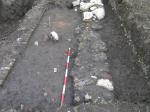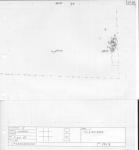Interpretation
-
- This wall is a later construction, as evidenced by the dry masonry style, reuse of Roman materials and the possible reuse of Roman wall as foundation. The function of this possible structure is unknown due to the lack of investigation. It is definitely post Roman in date and is no doubt associated with the compact paving contexts of SU (8012) and SU (8016), which may have served this structure.
-
- Darian Marie Totten
- 1-8-2008
Stratigraphic Relationships
- No Linked Records
- No Linked Records
Description
- struttura NS posta al limite E dello scavo
- orientation and position
- no later intervention
- dry masonry
- none
- x
- see plan
- none
- Varied stone: white stones with irregular sufaces, mid grayish green, medium grayish yellow with black inclusions 3-10 mm in diameter.
- x
- 3 visible reused brick fragments mid pinkish red with orangish red inclusions, approximately 2 mm.
- x
- not yet visible
- x
- Wall constructed in dry masonry (possibly to be revised with further excavation) oriented along the eastern end of trench near edge. Stones are of uneven rough surfaces (possibly roughly hewn) in varying shapes and sizes. There is also a concentration of tufa blocks in the NW corner, as well as other tufa blocks distributed randomly through the wall of a similar type. Bricks were also reused in this construction.
- Wall may continue further south as evidenced by the remnants of a possible rubble core with tufa pieces on the surface. This possible Roman wall, yet to be clearly discerned and not visible in section, may have been used in the later dry masonry construction. Further excavation necessary.
Basic Information
- struttura NS posta al limite E dello scavo
Plan
Record Details
-
- Lisa Fentress
-
- Andrea Di Miceli
- 1-8-2008
- Andrea Di Miceli
- 16-7-2008


